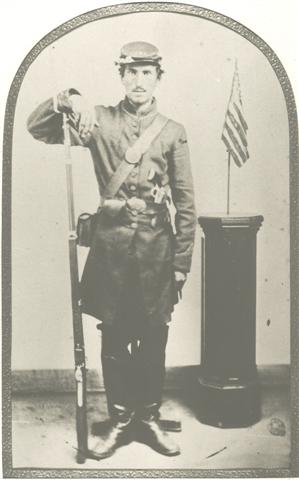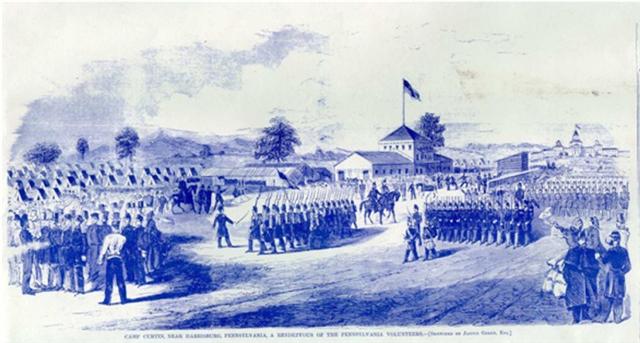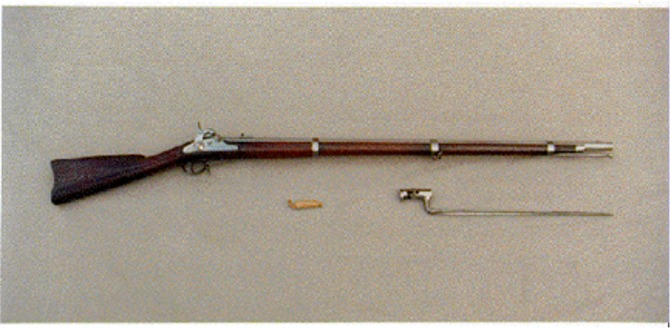David Demmy
Veteran of the
127th Regiment, Pennsylvania Volunteers Infantry
Company C
1862 – 1863
The War of the Rebellion – America’s Civil War
In the spring of 1862, the war was favored by the Southern troops. General Robert E. Lee, Commander of the Army of Northern Virginia, turned his attention to Pennsylvania having in mind the desire to capture 1) the coal mine industry, 2) the city of Harrisburg 3) the city of Brotherly Love, Philadelphia, and 4) eventually the bigger target, the Union’s capital, Washington, D. C.
On July 7th of that year, President Abraham Lincoln issued his Proclamation, calling for 300,000 volunteers to serve for three years or the duration of the war. Subsequently, Pennsylvania’s War Governor, Andrew G. Curtin, requested thousands of men to join and serve for shorter terms of service. These men became members of nine-month regiments. Many men of all ages were enticed to join the Northern cause to preserve the Republic. Teenagers and much older men, and many with families, left their children and wives, and their homestead and marched off to war.
I am David W. Demmy, Sr. I am the great, great-grandson of David Demmy who participated in the ‘Conflict Between the States’, better known as America’s Civil War. This story is about my great, great-grandfather, his younger brother, Levi, and other men of Central Pennsylvania, mostly from Dauphin County.
David Demmy was born in South Hanover Township, perhaps near Union Deposit. The Union Deposit Cemetery contains a number of his ancestors. David had just turned 22 years of age on Monday, August 4, 1862. The next day he came a running along with other young men of the region and joined forces with local Hummelstown Doctor, James Henderson.

David Demmy 1840 – 1922
Perhaps it was a romantic notion to leave home and seek out a little adventure. Perhaps he was bored with working on the farm; perhaps he was already tired of the little pay he received!
In those days, pay for farmers and unskilled-workers was a mere dollar-a-day. A private in the union army was promised $13.00 and perhaps an enlistment bonus was worth $100.00! On top of all that money, a fellow would be given new undergarments, shoes, and a uniform that generally did not fit. In addition, he would be supplied with his meals and would assuredly be given the opportunity to see other parts of young America, other than the hills of central Pennsylvania.
Hummelstown was a buzz with recruiting talk among the men folk of the surrounding countryside. Local Doctor, James Henderson, who had a very lucrative practice, began to recruit men to defend the Union to reunite the nation. Patriotism ran high among the folks of that day and age!
Our David was among the men whom boarded a train for Harrisburg. Upon arriving in Harrisburg, they walked up what is now Sixth Street to the entrance of Camp Curtin at what we know as Maclay Street. These men enlisted and became members of Company C, 127th Regiment Pennsylvania Volunteers. In those days, the men were allowed to elect their own officers from among themselves. Doctor Henderson was duly elected Captain of Company C.
Camp Curtin was laid out on the former Dauphin County Fair Grounds. It was bordered by the Pennsylvania Railroad, along Seventh Street, towards the river at Fifth Street, and from Maclay Street to Reels Lane. [Today, Reels Lane is a small alley near Division Street.] Camp Curtin was the largest training camp in the North. The headquarters buildings were probably constructed on the high ground along what we know today as Sixth Street.

Camp Curtin 1861 – 1865
Camp Curtin drilled the men in the ways of military performance and issued them their first blue uniforms. At last, on August 16th, the 127th Regiment was formed with men mostly from Dauphin County. Others were from Lebanon and other local counties. The 127th Regiment Pennsylvania Volunteers was familiarly known as the “Dauphin County Regiment.” The Harrisburg Patriot Newspaper Company was sure to follow the adventures of the One Hundred and Twenty Seventh Regiment.
Two days after the enlistment of David Demmy, his younger brother, Levi Demmy, who had just attained the age of 19, also left home and joined the 127th Regiment. And, there were men from Lebanon County that traveled to Camp Curtin. They became Company E. It was the patriotic duty of every able bodied man to go and fight for the government.
Still more men from Middletown, Dauphin County answered the call to come to the aid of the Union. One family from Middletown, answered that call. John K. Shott became the first Lieutenant of Company H. His son also joined. John’s wife was a very patriotic woman. Jeremiah Rohrer was elected Captain. On Saturday, August 9th he gathered his men at the Union Hall and began the march to the train station in Middletown. As they marched past his home, Jeremiah halted the men and dashed into his house. Upstairs his wife sat crying with a babe in her arms. At that moment, Jeremiah wanted to remain home, but honor and duty prevailed. They departed for Harrisburg. Men from Adams County made up Company I. And still, men came forward. Men from Schuylkill County made up Company K.
The men had drawn tents and rations and were drilled and drilled most of the week. On Thursday the 14th, they marched to downtown Harrisburg and each private was presented with fifty dollars that had been voted by and given to them by the Dauphin County Commissioners.
On Saturday, August 16th the regiment drew uniforms and marched to Wallower’s warehouse at the Pennsylvania Railroad and there they drew their gleaming Springfield rifle muskets. These citizen soldiers, uncertain of their near future, were proud of their new guns and blue clothing. It took some considerable time for a big fellow to swap a small uniform with a little fellow that had a very large uniform. Editor’s Note: Times haven’t changed much! In 1968, my army uniforms were too small and the army never did give me a pair of boots that fit nicely.

The 127th Regiment Penna. Vol. – Inf., departed Camp Curtin, leaving Harrisburg behind, on the Northern Central Railway on Sunday, August 17, 1862, at 09:30 a.m. They rode on flat cars; past York about noon, and then onto Baltimore about 05:00 p.m. They continued on the B & O Railroad to Washington, D.C. There they marched down Pennsylvania Avenue past the White House and over the Long Bridge on into Virginia, ever nearing the front lines. They began to feel that they were approaching the country of the enemy. And they were!
They garrisoned outside of the Capital where they were a part of the defences of Washington — the Capitol building and White House. Their first official duty was to guard the Chain Bridge to keep the Confederates from crossing over the Potomac River into the Capital city. Later they became attached to the Army of the Potomac and in November 1862, the Regiment marched to Falmouth, Virginia.
Falmouth is the village, just across the Rappahannock River from Fredericksburg, Virginia. Their first combat mission was at the Battle of Fredericksburg. They performed in the Chancellorsville Campaign and the Operations at Franklin’s Crossing, Maryes Heights, Fredericksburg, Salem Heights and Bank’s Ford before returning to Camp Curtin to be mustered out on May 29, 1863.
Following the war, in 1863, he married Lydia Staley in Palmyra. He was a farmer living in Linglestown RD or Grantville. Two of their children died at birth. Upon his retirement, he lived with his son, William F. Demmy in Penbrook. William’s sister, Clara, lived next door in the duplex house.
In June 1912, at the age of 72, his civil war pension was $24 a month.
Upon his death at age 81 in 1922, his death benefit was $100 and his estate was bestowed $75 from the Dauphin County Commissioners for his Civil War service. His burial in Shoop’s Cemetery, Lower Paxton Township, cost $201.50. I suppose that was before someone invented the word, ‘inflation’. His tombstone must have been very expensive! It looks nearly new after 77 years! In comparison, the names and dates on tombstones in the Union Deposit Cemetery are wornnearly away.
The Camp Curtin Historical Society and Civil War Round Table meet in the United Methodist Church on Sixth Street. History about the church is in the Society’s recruiting brochure. Does anyone know what is on the wall behind the alter in this church? It is a painting of The Lord administering to a wounded Civil War soldier, who is wearing a portion of a rebel as well as a Yankee union. Camp Curtin is currently raising funds to restore the damaged painting. In the past Camp Curtin has helped with the restoration and preservation of the 17th Pennsylvania Cavalry monument in Gettysburg and has been instrumental in having State Markers placed thru-out the area.
Camp Curtin Historical Society membership is $20.00 a year — well worth the fee to receive the Outstanding quarterly news, The Bugle. Also, members are entitled to 50% discount on magazines like Civil War Times, World War II, and other Primeda Group historic magazines.